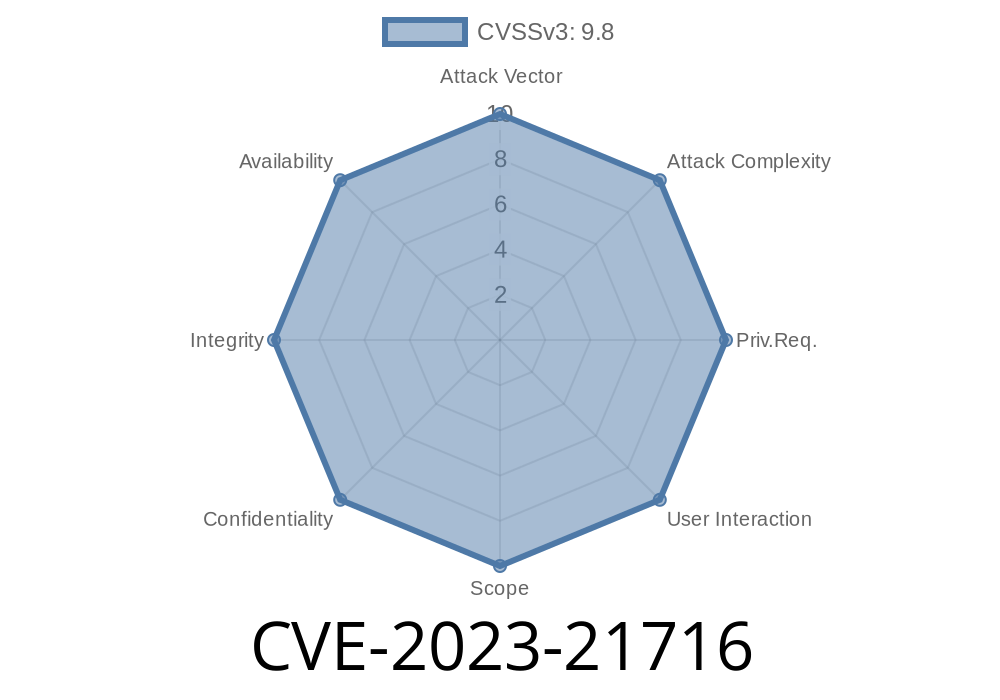In today's digital world, cyberthreats are lurking around every corner. Microsoft Word, one of the most popular and widely used office applications, is not immune to these threats. Recently, a new vulnerability has been identified with the code CVE-2023-21716. This vulnerability exposes users to remote code execution attacks, potentially allowing attackers to take control of affected systems.
In this post, we'll provide an in-depth look at CVE-2023-21716, outline the exploit details, and discuss how to stay safe from this vulnerability. You'll learn about the code snippet that makes this remote code execution possible and explore links to original references that can help you better understand and address this threat.
Code Snippet
At the heart of CVE-2023-21716 lies a specific code segment in Microsoft Word that opens the door to remote code execution. The code snippet below demonstrates the vulnerability, which results from improper handling of specially crafted Word documents.
// Vulnerable code snippet
int parseDocument() {
...
offset = read(doc); // Read data from the document
...
jumpTable(offset); // Use the offset to perform a jump or call instruction
...
}
Original References
To fully understand CVE-2023-21716, it's essential to familiarize yourself with the original sources documenting this vulnerability. Below are some key links with in-depth information:
1. National Vulnerability Database Entry: The official CVE entry in the National Vulnerability Database (NVD), which provides detailed information on the vulnerability's impact, severity, and mitigations.
2. Microsoft Security Advisory: This advisory from Microsoft offers an overview of the vulnerability, serving as a reliable source for guidance and remediation methods.
3. Exploit-DB Report: A detailed account of the vulnerability and the proof-of-concept (POC) exploit, submitted by security researchers.
Exploit Details
When an attacker leverages CVE-2023-21716, they create a specially crafted Microsoft Word document to trigger the code responsible for the vulnerability. Once the document is opened or previewed by the victim, the exploit executes arbitrary code with the same privileges as the victim, potentially leading to full system compromise.
The specially crafted document contains carefully chosen offsets and crafted data, which ultimately trick the vulnerable code into executing unintended instructions. As such, the attacker gains control of the affected system, potentially leading to data theft, system sabotage, or further malware infections.
Staying Safe
Considering the widespread use of Microsoft Word, it's crucial for users to protect themselves from CVE-2023-21716. Below are some essential steps you can take to stay safe:
1. Update your software: Regularly check for software updates and apply them as soon as they become available to ensure your computer is protected from known vulnerabilities. Microsoft has released a patch that addresses CVE-2023-21716, so make sure to install it promptly.
2. Be cautious with attachments: Exercise caution when opening email attachments, especially from unfamiliar sources. Even if an email appears to be legitimate, verify its authenticity before opening any files.
3. Use antivirus software: Always keep your antivirus software up to date to protect your system from threats. Most antivirus programs should include coverage for CVE-2023-21716, but it's best to verify.
4. Implement security best practices: Follow security best practices, such as using strong passwords, enabling two-factor authentication, and keeping backups of important data. Additionally, consider utilizing a separate user account with limited privileges for everyday tasks, rather than using an administrator account.
Conclusion
CVE-2023-21716 is a severe vulnerability that poses significant risks to Microsoft Word users. By understanding this vulnerability, keeping your software updated, and following security best practices, you can safeguard your system from potential attacks. Always be vigilant when dealing with files from unknown sources and stay informed of the latest cybersecurity developments to help protect your valuable data and maintain system security.
Timeline
Published on: 02/14/2023 20:15:00 UTC
Last modified on: 02/23/2023 15:43:00 UTC
